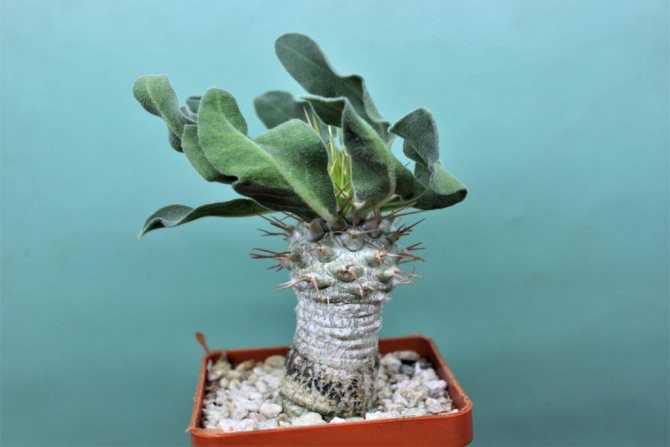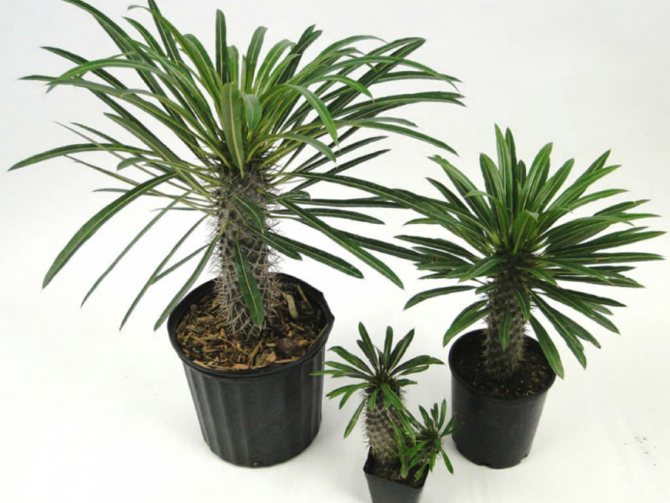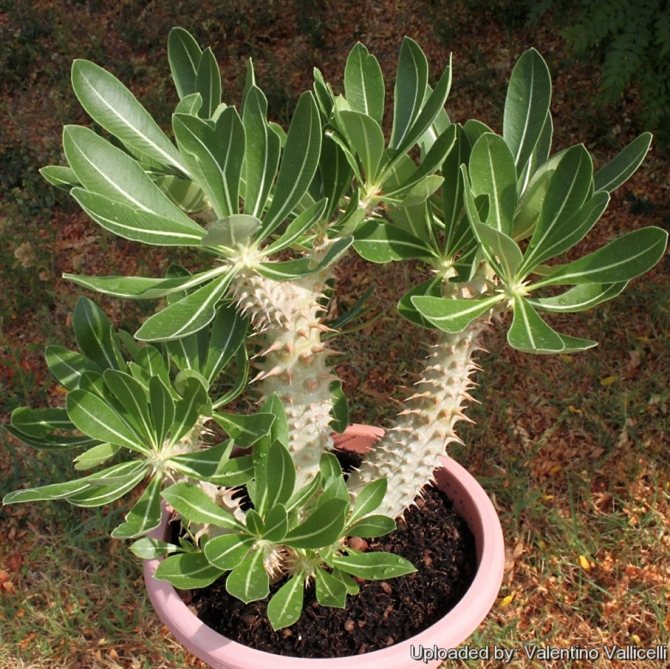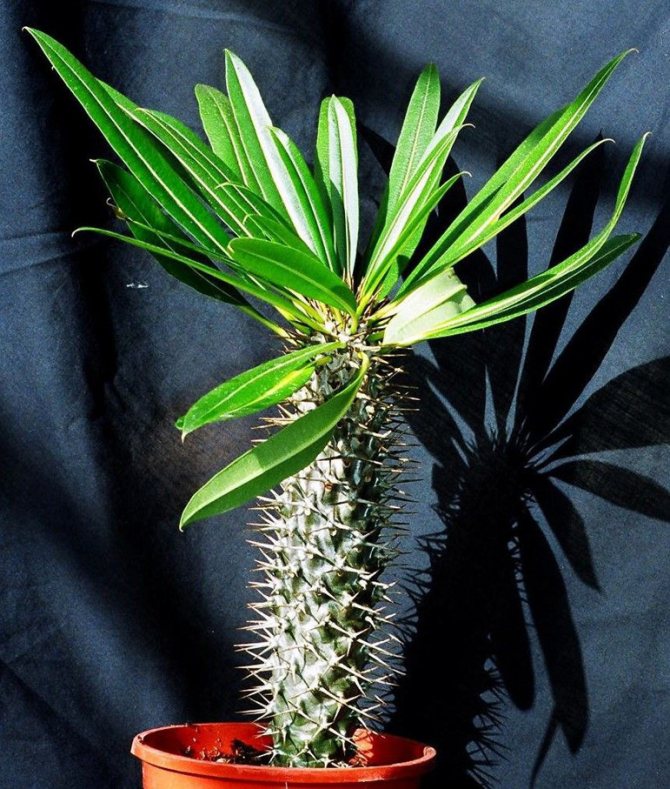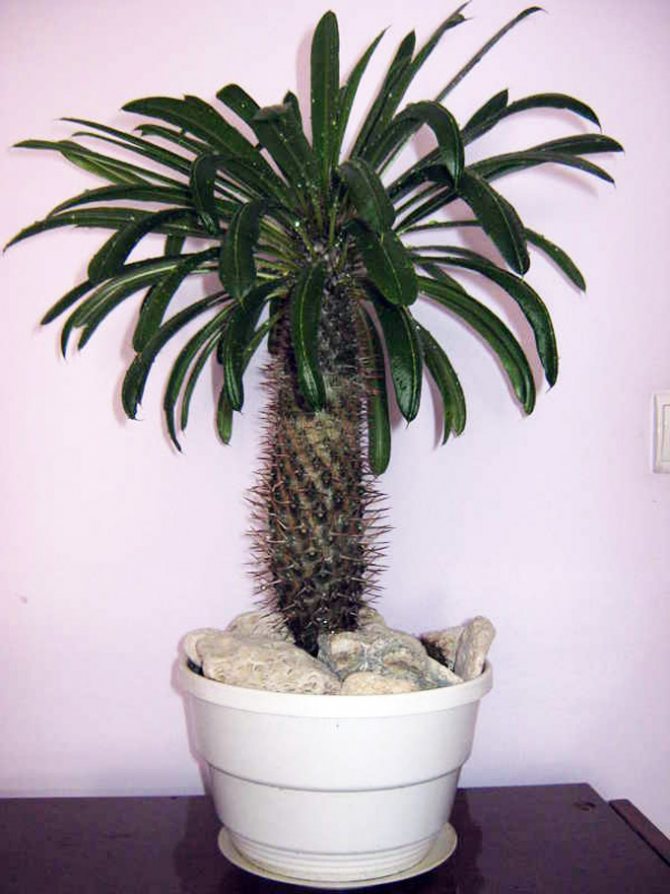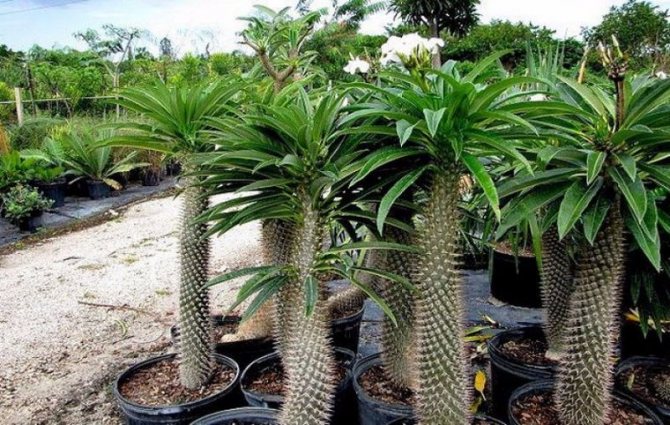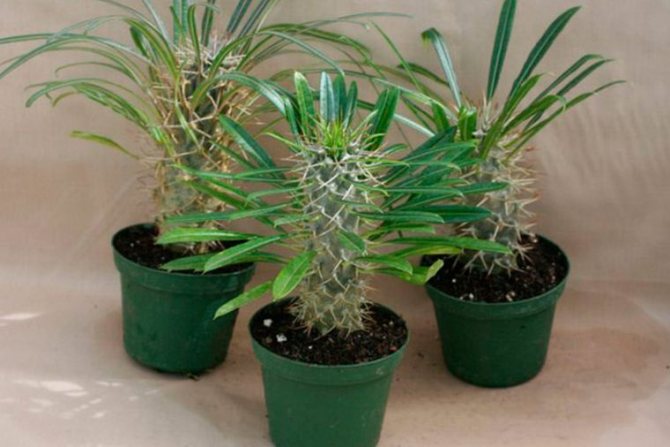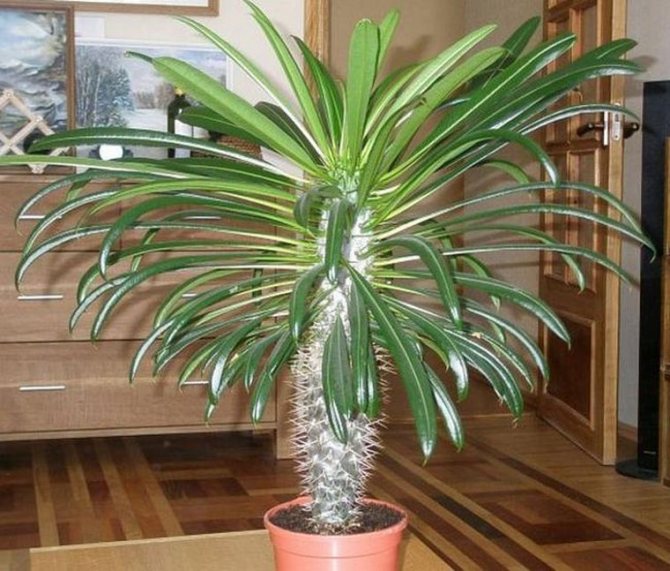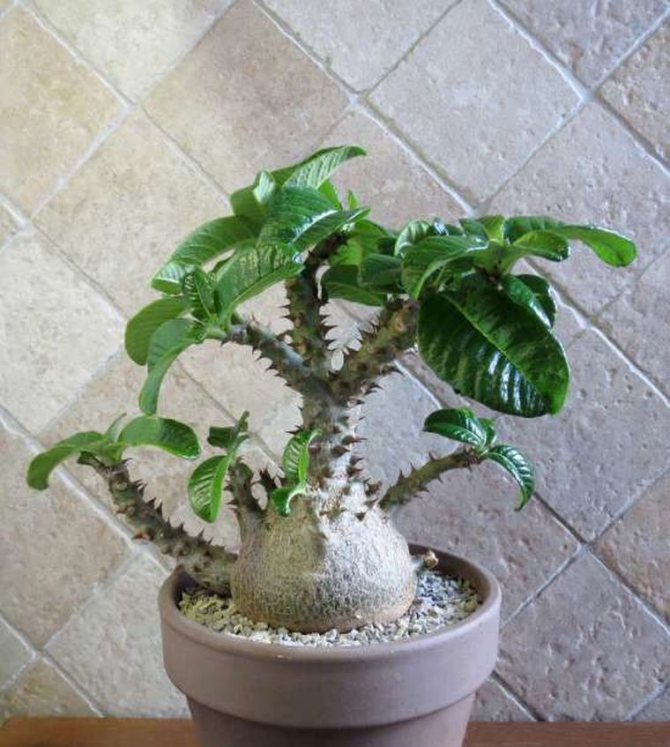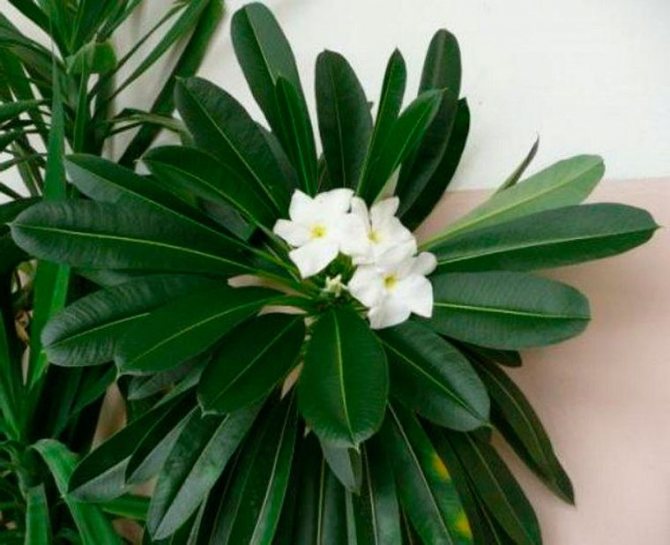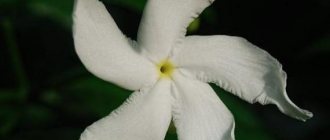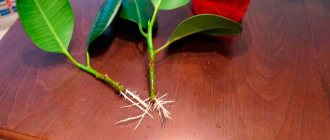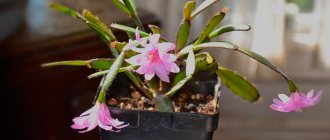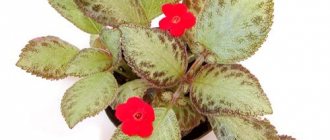Original exotic pachypodium flower. It simultaneously resembles a palm tree and a cactus. It is similar to a cactus in that it is a thick-legged, fleshy succulent.
Located at the very top, thin leaves are very similar to palm leaves. And such a handsome man comes from the Kutrov family. In the Kutrov family, there are many species of this plant. They grow in size from a few centimeters to the height of a three-story building.
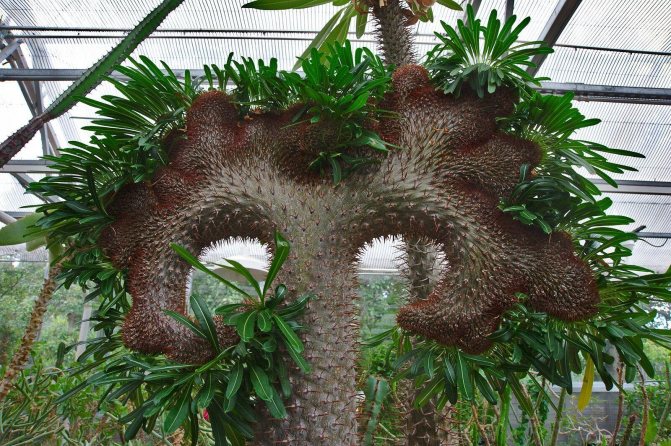
When kept at home, the pachypodium can only grow up to 150 cm.It can be grown in several ways. It is not difficult to keep such a handsome man, he grows well in an ordinary apartment. The main thing is to know how to properly contain it.
Features of the pachypodium
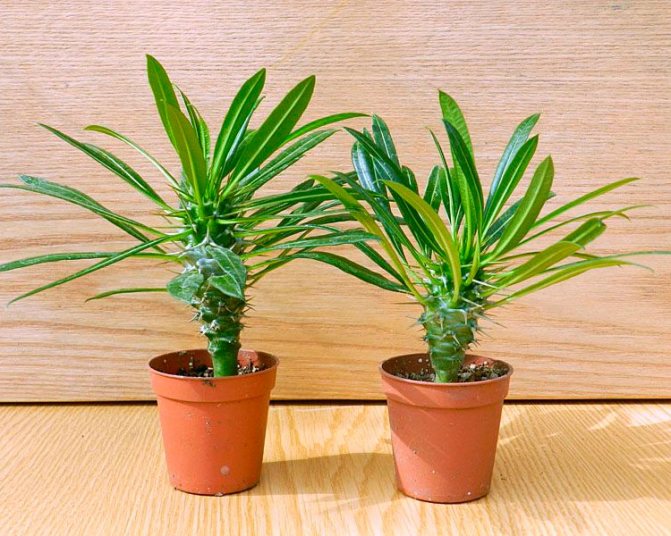

The pachypodium is a succulent tree or shrub. With a large number of differences between varieties and species, such plants have such a characteristic feature as a thick trunk, in which a supply of liquid accumulates in case of drought. Outwardly, the species that make up this genus are very different from each other: from cactus-like trees to bottle-shaped dwarfs. Almost all species of such a plant have thorns, which are grouped in 2-3 pieces, they are placed around the trunk in rings or spirally. Only a part of the species of this genus does not form branches, and the rest of the species are distinguished by rather strong branching. This genus differs from other representatives of the Kutrov family in that such plants have transparent juice, not milky, but still it is poisonous. When grown at home, the height of the pachypodium varies from 0.3 to 1.5 m, while its lifespan is 3-15 years.
Botanical Description, Poisonous or Not
Pachypodiums are succulent trees and shrubs that are capable of accumulating moisture in their body parts during precipitation and gradually giving it back to the roots during drought. All species have a different appearance, but the main feature of the genus is considered to be a thickened trunk, resembling a bottle in its shape.
Also, spikes are located throughout the trunk, protecting the trunk from being eaten by animals. The thorns grow together with the leaf mass. After the leaf falls off, a hardened thorn remains in its place. If it is broken for any reason, it will no longer recover.
By its appearance, the Pachypodium is divided into:
- Dwarf plants that do not grow above 8 cm during growth, but their diameter reaches 40 cm.
- The trees are 4 m high, resembling bottles in their appearance.
- Trees that look like cigar-shaped cacti and have a height of up to 5 m.
In home cultivation, all species grow significantly less and do not live longer than 15 years.
The pachypodium has a poisonous internal sap. Therefore, when working with a plant, you must follow certain rules and make sure that the juice does not get on the mucous membranes of a person. If this happens, it is necessary to quickly rinse the affected part with running water and consult a doctor. The juice causes severe irritation when it gets on the mucous membranes.
Handsome pachypodium in the photo:
Pachypodium care at home
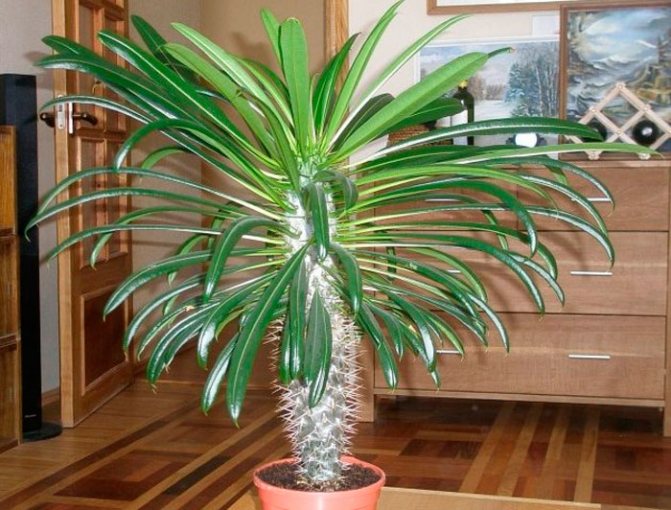

Illumination
The pachypodium needs a lot of light, and it must be borne in mind that the direct rays of the sun do not harm it. In the summer, it is recommended to move it to fresh air (in the garden or on the balcony), but it must be accustomed to the new conditions gradually.When choosing a suitable window for a room, it is recommended to prefer one that is located in the southwest, south or southeast part of the room. When spring comes after winter with its short daylight hours, the plant must also be gradually accustomed to direct sunlight.
Temperature regime
The bush responds well to frequent ventilation, as it loves fresh air, but it must be protected from drafts. In summer, the pachypodium does not differ in its exactingness to the air temperature; it can grow and develop normally at both 18 and 28 degrees. In winter, when he has a dormant period, he needs to be rearranged to a cool place (from 16 to 18 degrees).
How to water
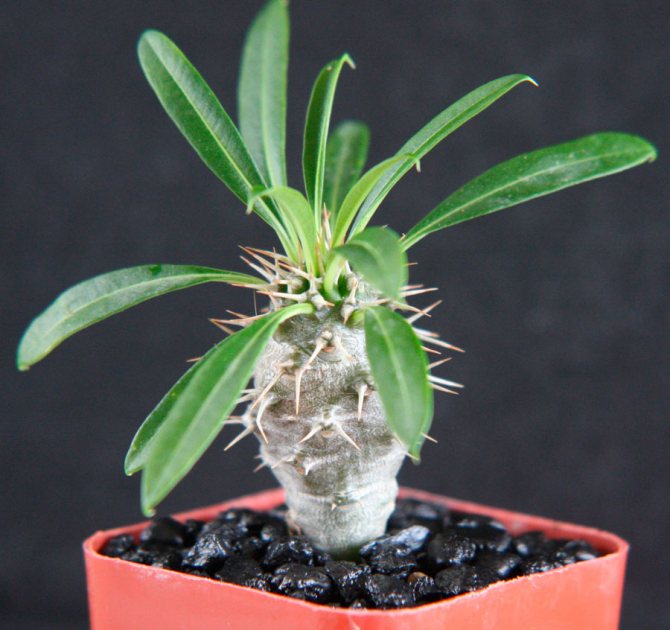

When grown indoors, it is very easy to care for such a plant. In the spring-summer period, it should be watered sparingly, while the soil mixture in the pot should be constantly slightly damp. When there is a lack of water, the foliage is observed flying around the bush, which makes it less attractive. If, on the contrary, there is too much water, then the bush will become painfully elongated, which also has an extremely negative effect on its decorative effect. Watering is carried out immediately after the substrate dries to a depth of 10 mm. When growing a short-stemmed pachypodium, it is poorly watered throughout the year. In the event that all the foliage falls off the bush, then it must be stopped completely watered, and after only about 1.5 months it will grow back. It should not be forgotten that such a culture is watered only with well-settled water.
Air humidity
This flower does not need high humidity. However, it is recommended to moisten it from time to time from a sprayer with well-settled water at room temperature, and before that, all its sheet plates must be wiped with a moistened soft cloth or sponge.
Top dressing
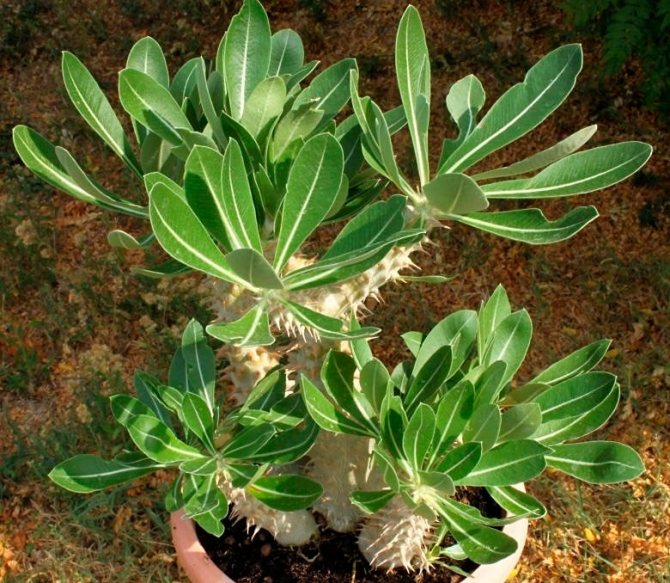

They begin to feed such a flower at the beginning of the spring period after the bush begins to grow new shoots, and they do this until mid-autumn. To do this, use a fertilizer solution for cacti, which must be applied once every 4 weeks to a previously watered substrate. For 4 weeks after transplanting, as well as when the bush is sick, no feeding is carried out. Before the plant enters a dormant period, it is completely stopped feeding. They begin to feed again only with the onset of the next spring period.
Pachypodium transplant
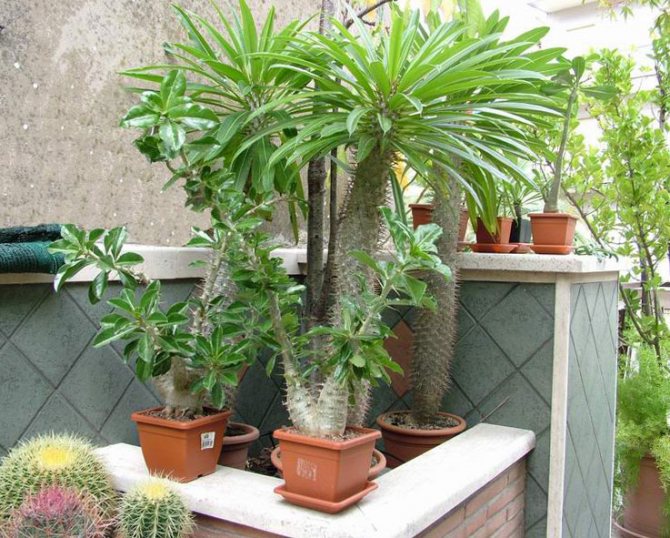

While the pachypodium is young, it needs an annual transplant into a larger container, and this procedure is carried out in the spring. Adult specimens are transplanted much less often, as a rule, once every 3 or 4 years. A moderately acidic soil mixture for cacti is best suited for growing such a flower. Such a substrate can be made by hand; for this, leaf and sod land are connected, as well as coarse-grained river sand (1: 1: 1). In order for the soil mixture to be well-drained, charcoal or brick chips should be added to it. Before planting in a new pot, you need to make a good drainage layer; for this, expanded clay is poured into it, which should fill the container by 1/3 part.
When transplanting, you need to be very careful, as you can easily injure the root system of the bush. If the flower is not sick with anything, then it just needs to be transferred into a new container, while the remaining empty space must be covered with a previously prepared substrate (see above). If the bush has a diseased root system, then first you need to carefully remove the remnants of the old soil mixture from it, then cut out all dried or rotten areas and sprinkle the wounds with crushed charcoal. And then the bush is planted in a new pot.
Bloom
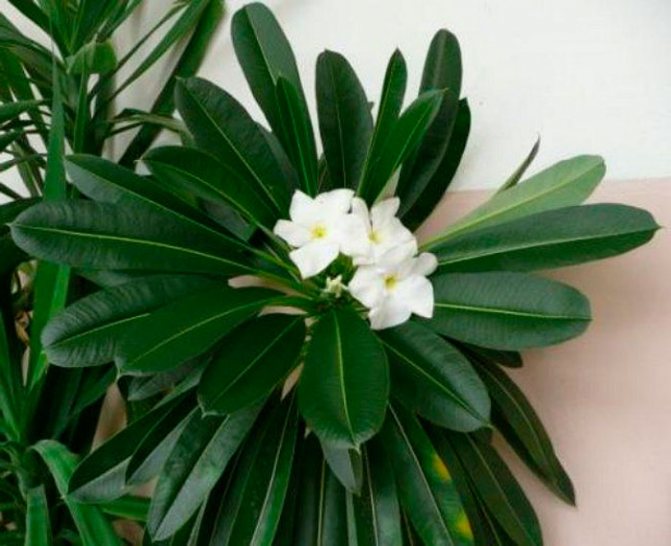

The pachypodium is a slow-growing plant, therefore it blooms for the first time only when it is 6 or 7 years old.However, if he is provided with the wrong or poor care, then flowering may never come at all. If you take proper care of the plant, protect it from drafts, feed and water it in time, choose the right place in the room, then you may be able to see the flowering of the pachypodium.
Virulence
The bush contains poisonous juice. If it gets on the mucous membranes, it will irritate them, and this juice also eats away at the wounds on the skin. In this regard, the area of the skin that has gotten the juice must be rinsed with plenty of running water.
Bloom
Since the plant develops very slowly, the first flowering occurs only at the 7th year of its life and provided that it has developed well all this time and has not been sick. Therefore, during cultivation it is necessary:
- Water the plant in time.
- Fertilize.
- Arrange cool content in the winter.
- In the spring, transplant into fresh soil with an increase in the volume of the pot.
Good home care will help the pachypodium bloom.
Reproduction of the pachypodium
Growing from seeds
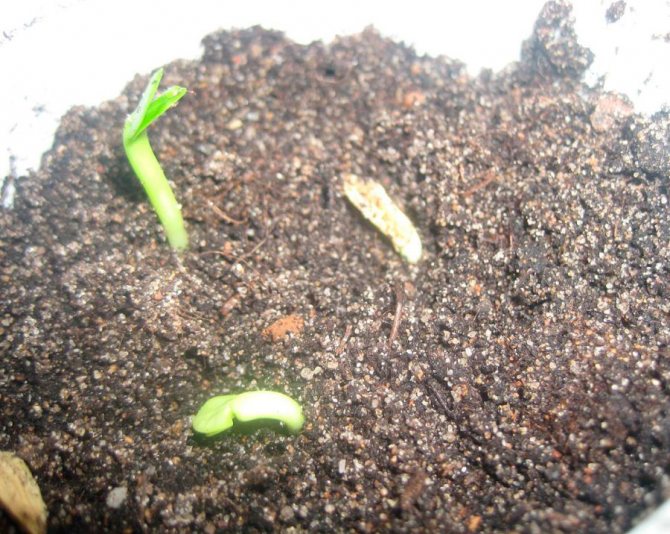

The pachypodium can be propagated by the seed (generative) method, but it should be borne in mind that it is rather difficult to get the seeds of such a plant in indoor conditions on your own. When sowing, the seeds are buried into the substrate by 5 mm; on top of the container, the container must be covered with a film or glass. Then the crops are harvested in a well-lit cool (about 20 degrees) place. When the first seedlings appear, the shelter should be removed, however, they do it gradually, accustoming the plant to new conditions. After the seedlings are strong, they should be dived into individual pots, and then they are provided with the same care as the adult bushes. Before deciding on this method of reproduction, one must take into account that the pachypodium grows from seeds very, very slowly.
Cuttings
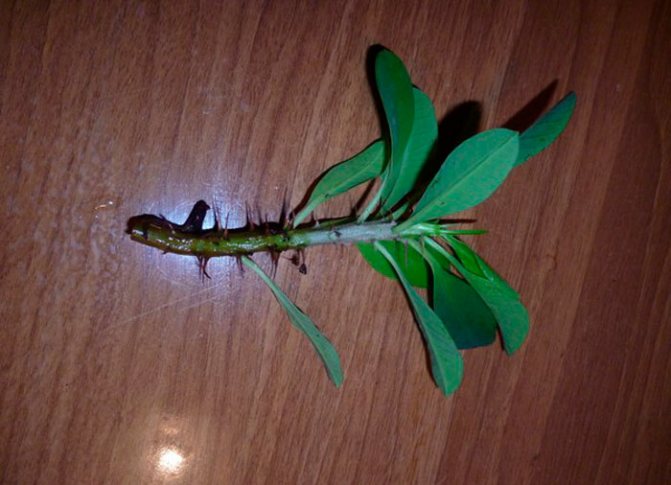

This plant can be propagated by cuttings, but such cuttings very rarely root normally. However, there are cases when the top of a bush that has rotted at the base was cut off, and it successfully rooted. To do this, cut off the upper part at a height of 15 centimeters using a very sharp pre-sterilized tool, sprinkle the cut with crushed charcoal, and then plant the cutting in a soil mixture intended for planting an adult pachypodium (see above). Place the cutting in a well-lit area.
How to choose the right soil for the pachypodium?
Often a plant transplant is required for various reasons, and in this case you need to know which soil is considered ideal for these purposes, as well as how to properly prepare it. For this, the recommendations of experienced florists are taken into account:
- loose soil is considered an ideal choice, allowing water and air to pass easily to the roots of the pachypodium;
- in flower shops you can choose a special mixture designed for growing cacti;
- it is allowed to make the optimal mixture with your own hands, for which deciduous earth is used, mixed with sand and humus.
Of course, drainage is made at the bottom of the pot so that the water does not stagnate in the pot, which can lead to rotting of the plant.
Pests and diseases of the pachypodium
Diseases
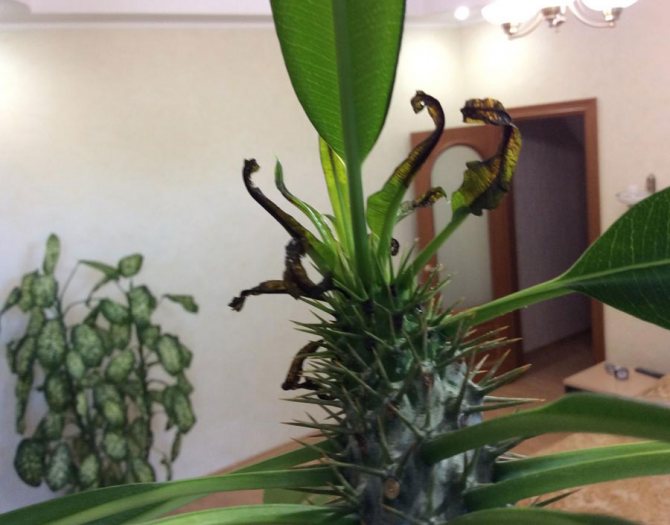

When grown indoors, the pachypodium is highly sensitive to too much moisture, and this is expressed in the appearance of a variety of rot. In order to protect the bush from fungal disease, it must be properly watered. It should also be borne in mind that such a succulent plant tolerates drought much easier, but stagnant water in the substrate can cause rotting and thinning of the stem, as well as blackening and flying around the foliage. As soon as you notice that the bush has begun to rot, you must immediately suspend watering and remove it to a warm place.The plant and soil mixture in a pot must be sprayed with a solution of a fungicidal preparation, and in order to prevent relapses, it is imperative to revise the watering regime.
Harmful insects


If the air humidity in the room is too low, then spider mites can settle on the plant, which suck cell sap from the bush. It is almost impossible to see such a tick with the naked eye, however, a sure sign that a bush is occupied by such a pest is the presence of a thin web on its surface. To get rid of this pest, the pachypodium must be thoroughly rinsed under a warm shower, and it is also recommended to increase the humidity in the room. To do this, every evening the plant must be moistened from a sprayer with well-settled lukewarm water. In the case when there are a lot of ticks on the bush, acaricides such as Aktellik, Fitoverm, Aktara or Akarin are used to destroy them.
If the room is relatively hot and the air humidity is low, then thrips can settle on the pachypodium. This pest also sucks the cell sap from the flower. In this case, light-colored dots and silvery stains are formed on the front surface of the leaf plates. In this case, the harmful insects themselves are on the seamy surface of the foliage. You can get rid of such a pest with the same drugs that are used in the fight against spider mites.
Watering and air humidity
For a comfortable development, the pachypodium must be reliably protected from waterlogging. Like any succulent, the Madagascar palm tree does not tolerate damp conditions and watering for it should be restrained. The frequency of the procedures is selected so that between them the upper and partially the middle layer of the substrate dries out. The soil in the pot should always remain slightly damp. And so scanty watering in winter is reduced to minimal. Yellowing of the leaves serves as a signal for the transition to a new stage of development, the beginning of the dormant period. From the moment the first signs appear, watering is sharply reduced, only maintaining the minimum vital humidity and the usual humidity level is not renewed until spring.
The Madagascar palm is a drought tolerant plant that can forgive short droughts. But since the plant does not immediately react to the drying out of the soil, only after several weeks, in order to maintain the high decorative foliage, it is better not to allow complete drought even in winter. The only exception to the rule is the short-stemmed pachypodium, which should grow in an almost dry substrate all year round.
Like all succulents, the luxurious pachypodium will save you the hassle of humidifying your air. This plant requires a dry climate, it is very comfortable even in living rooms with active heating devices. Moreover: the Madagascar palm tree will not be scared even by the location next to the batteries.
The purity of the leaf plates is very important for this Madagascar pseudo-palm. Do not allow dust to accumulate on the leaves of the plant, regularly wiping the greens with a damp sponge.
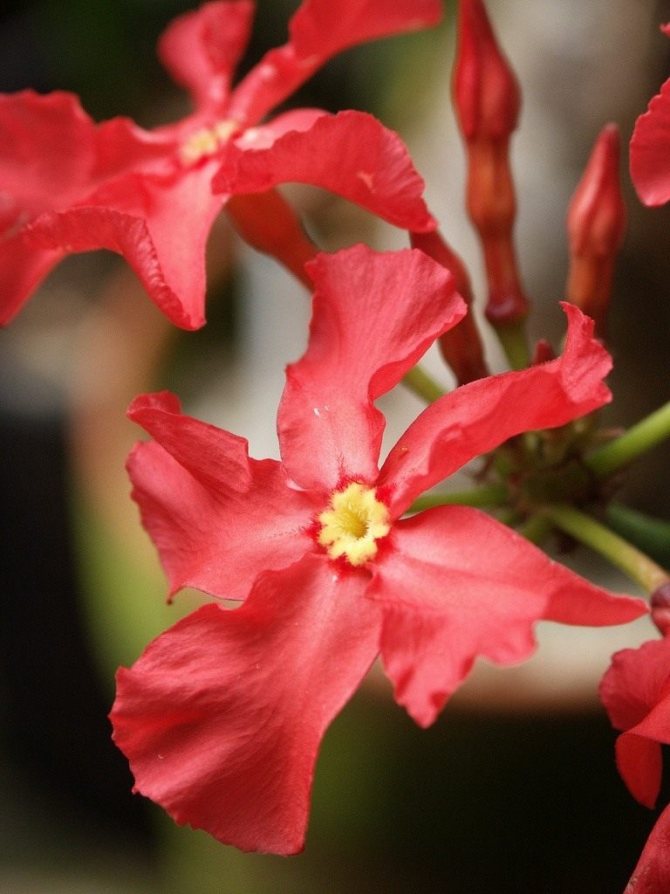

Flowers of pachypodium rosette.


Flowers of the Sanders pachypodium.
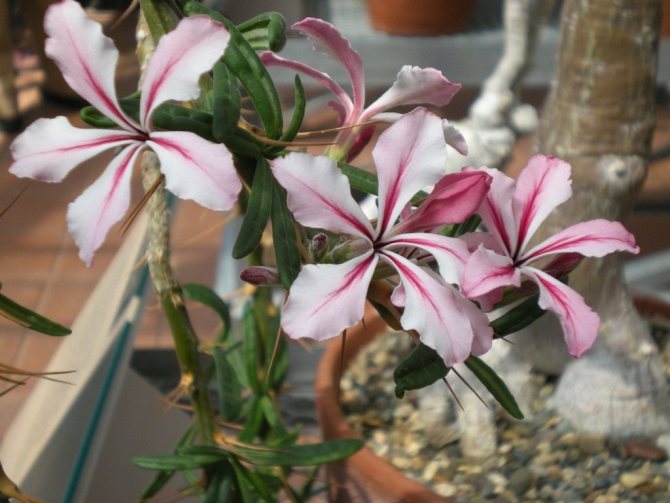

Flowers of succulent pachypodium. <>
Types and varieties of pachypodium with photos and names
Pachypodium lamerei, or Madagascar palm


This species is a tree, the height of which can reach 600 cm. Its trunk is thick and prickly. In adult specimens, the foliage at the top of the trunk is located in almost the same way as in a palm tree; it is with this feature that the second name of this species is associated. The thickened erect stem lignifies in the lower part, on its surface there are protruding tubercles, which are arranged in a spiral. Each tubercle has 3 powerful spines. A rosette is formed on the upper part of the stem, which consists of dark green petioled leaf plates with an elongated lanceolate shape, their length varying from 0.2 to 0.4 m.3 bare spines grow under each leaf plate. White-cream or pale pink flowers have a yellow center, in diameter they reach about 11 centimeters. The green fruits are oval in shape. When grown indoors, the height of the bush does not exceed 50 cm.This species has several varieties:
- typica - pubescent seamy surface of leaf plates;
- ramosum - a branched trunk is decorated with leaf plates with a pronounced central vein, umbellate inflorescences consist of white flowers, which reach about 10 centimeters in diameter.
Pachypodium geayi


The height of such a tree varies from 300 to 600 cm. Its trunk is thick and covered with thorns. While the plant is young, it is very similar to Lamer's pachypodium, but its foliage is narrower (width from 10 to 30 mm), and there is pubescence on its surface. The color of young spines is grayish, but the tips are black. White flowers have a yellow center. At home, the height of the bush does not exceed 0.5-0.6 m.
Pachypodium short-stemmed (Pachypodium brevicaule)
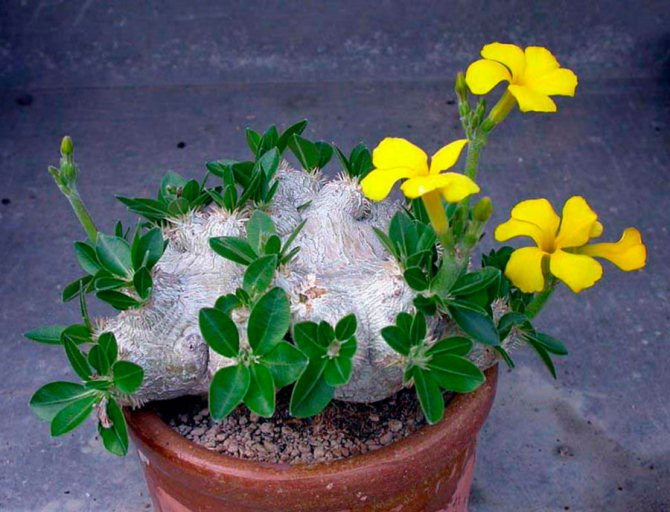

There is no foliage on the bush, it looks like gray stones that surround it in natural conditions. The tuberous flat stem, covered with thorns, reaches a height of about 0.6 m. During flowering, elongated yellow flowers open on the bush.
Pachypodium saundersii
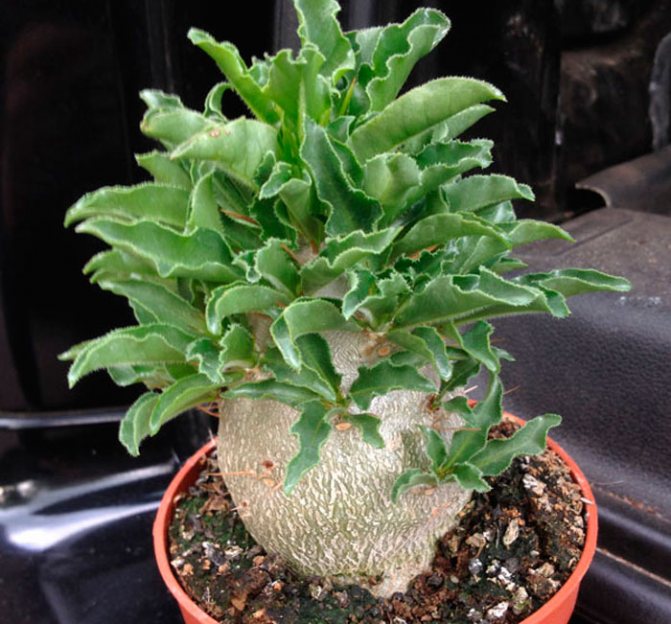

The stem of such a succulent plant is greenish-gray, almost spherical, in height it reaches about 150 cm. On the surface of the bush there are a small number of thorns, which reach 25 mm in length. The shape of the leaf plates is broadly lanceolate, while their apex is pointed. During flowering, a large number of white flowers grow on the bush, with a pink stripe on each petal.
Pachypodium succulentum
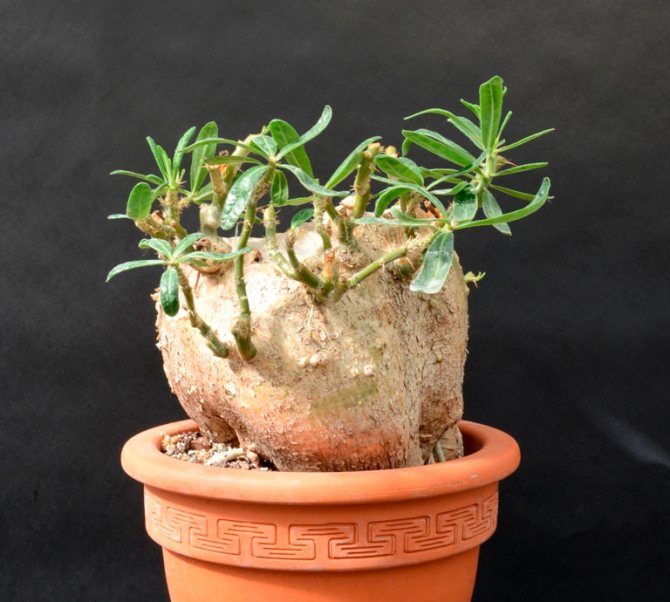

The bush has a turnip root, which gradually turns into a thickened tuber, reaching 15 centimeters in diameter. Above, the root becomes a stem, which lignifies over time, it is branched and branched, and its height varies from 0.6 to 0.9 m.There are paired spines on young branches, the length of which is from 10 to 20 mm, and a little pubescent leaf plates lanceolate, their length is about 50 mm, and their width is up to 10 mm. Flowering is observed in summer, at this time the bush is decorated with bell-shaped flowers of light pink color with a red throat, their diameter is about 40 mm.
Pachypodium densiflorum
Such a succulent shrub is characterized by slow growth, its height does not exceed 0.45 m.The fleshy trunk of a greenish-gray color is covered with thorns, it reaches 0.3 m in diameter.In the apex of the trunk there is a leaf rosette, consisting of leaves, the front surface of which is green , and the wrong side is gray-felt. Tubular rich yellow flowers reach 30 mm in diameter, they have a widened end, and the existing yellow anthers form a cone.
Pachypodium horombense


This not very tall plant has a smooth wide greenish-silvery trunk, which is thickened at the base. Narrow small leaf plates of greenish-gray color form rosettes on the tops of branches. Long pedicels have yellow flowers.
Pachypodium meridionale
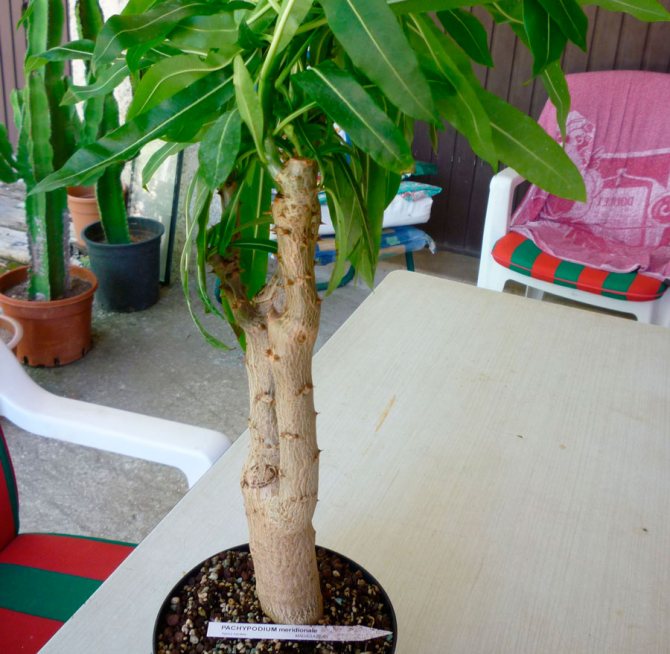

In nature, such a plant reaches a height of 300 cm, but when grown at home, the bush does not exceed 120 cm.The narrow and long leaf plates are green in color. The smooth brownish-silvery trunk reaches about 0.6 m in diameter. The large flowers have a pleasant aroma, they consist of a pale red corolla and pink petals.
Pachypodium rosette (Pachypodium rosulatum)
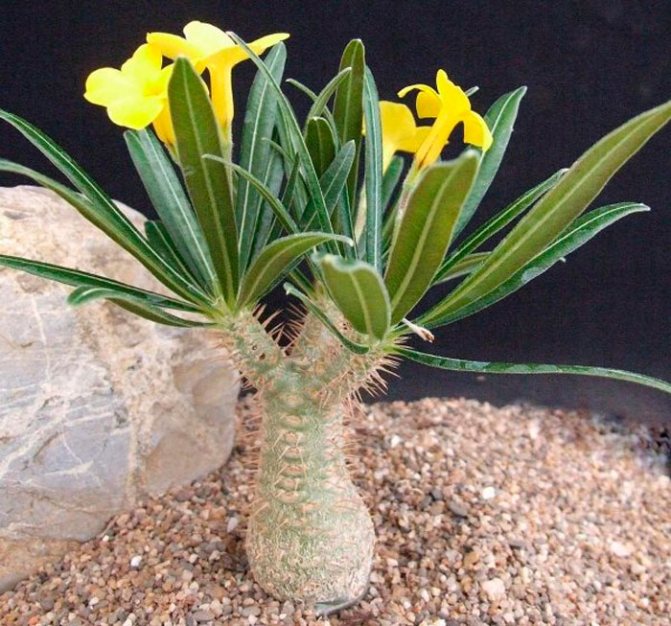

Such a fleshy succulent plant has upright cylindrical branches and caudex. Greenish-gray short trunk thickened at the base. There are a large number of thorns on the surface of the branches. Leathery shiny green leaf plates of a narrowed-oblong shape have a light-colored central vein. Foliage grows at the tops of branches, and it is collected in rosettes or whorls.Small-flowered racemose inflorescences with long pedicels, consist of tubular flowers of yellow or yellow-green color.
This species has a variety - elegant (Pachypodium rosulatum var. Gracilius): the height of the shrub is from 0.4 to 0.6 m with a caudex of brownish or gray color, it is round and slightly compressed from the sides, it can be smooth or there is a large the number of thorns. The branches are winding, short, they can be spiny or smooth. At the tops of the branches there are leaf rosettes. The rich yellow flowers are grouped on long pedicels, they are tubular and have a widened end.
Pachypodium rutenbergianum
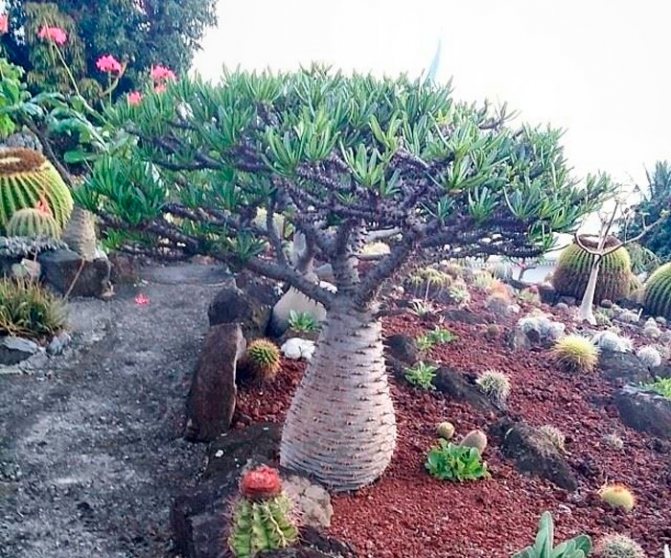

In nature, such a caudex plant reaches a height of 8 meters, but when grown at home, it does not exceed 0.6 meters. On the surface of the short branches, there are thorns, reaching about 10 mm in length. Dark green shiny leaf plates have an oblong shape and a light central vein. They are collected in sockets at the tops of the branches. The foliage is about 15 centimeters long and up to 4 centimeters wide. Terminal inflorescences consist of 3 or 4 large white flowers, which have a tube widened towards the end.
Comfortable temperature
In order for the pachypodium to become a decoration of your interior, all you need is to provide it with a warm location. This plant does not tolerate cold and lower temperatures below 15 degrees (with the exception of Lamer's pachypodium, which can withstand a cool winter from 8 degrees Celsius). Lower temperatures compared to the active season have a beneficial effect on the attractiveness of foliage and flowering, but such a decrease should still remain within the usual ranges of room indicators. The pachypodium is a heat-resistant culture that will cope well even with the heat. Not only in summer, but also from March to September, the plant will calmly withstand even air temperatures above 30 degrees Celsius.
Madagascar palm tree is not afraid of summer "vacation" in the open air. The pachypodium can be taken out into the fresh air in June and kept in the garden or on the balcony until the autumn cold snap. But when choosing a new place for a plant, try to reliably protect the false palm from precipitation and drafts. Lighting during exposure to fresh air does not need to be reduced: the pachypodium will feel great even in the brightest place. True, it is better to soften the transition by gradual adaptation both during the leader and when returning back.


Pachypodium horombense.
Growing difficulties
The main difficulty in growing a pachypodium is diseases of the root system, which lead to its decay. The development of these diseases occurs with improper care, as well as when transplanting and planting in non-disinfected soil. Diseases are treatable with corrective care.
Despite the rot of the root system, there are other difficulties in growing:
- drying of foliage - the irrigation regime is violated, pests attacked, there is a root disease. To eliminate the problem, it is necessary to regulate watering; pests are fought with the help of insectoacaricides;
- stunting - overheating of the plant. It is necessary to adjust the temperature according to the season;
- barrel deformation - wrong lighting, broken root system. It is necessary to adjust the lighting, transplant the plant.
Frequent problems
- If you water the palm too much, it can lose all its foliage.
- Fresh leaves darken and fall off - too little light or watering with cold water.
- With poor watering, the succulent loses its lower leaves.
- Cold and excessive watering can rot the trunk.
- The foliage wilted, and the stem wrinkled - too poor watering.
Pests
The pachypodium can be attacked by:
- Red spider mite
- Shield
- Thrips
- Aphids
Fight enemies you can use folk methods or insecticides. Often, a simple laundry soap helps to cope with them, with the help of which the victim is washed.
Pachypodium is an unusual and original plant that can emphasize the originality of a florist. Impressive thorns, expressive "hair" and delightful bloom - all this speaks in its favor. You just need to give the succulent suitable conditions and take minimal care of it - and the green pet will delight you with a lush rosette of leaves, a beautiful and strong stem and the most delicate fragrant flowers.
1. Seven Secrets of Success:
| 1. Growing temperature: summer - 16 - 24 ° С, winter - it is advisable to provide aloe with a cool rest period at a temperature of about 12 ° С. |
| 2. Lighting: the plant is very light-requiring. |
| 3. Watering and humidity: Dry the substrate between waterings a few centimeters deep, or even a third or half the height of the pot, depending on the air temperature. With the onset of warm weather, it is better to increase the air humidity. |
| 4. Features of the: a spectacular and at the same time extremely undemanding plant, with the content of which even novice growers can cope. |
| 5. Priming: well-drained, slightly acidic pH, can be a nutrient-poor substrate. |
| 6. Top dressing: a highly diluted solution of fertilizers for succulent plants 2 times a month in the warm season. No feeding is carried out in autumn and winter. |
| 7. Reproduction: stem cuttings, less often seeds. |
Botanical name: Pachypodium.
Pachypodium flower - family... Kutrovye.
Origin... Madagascar, Africa
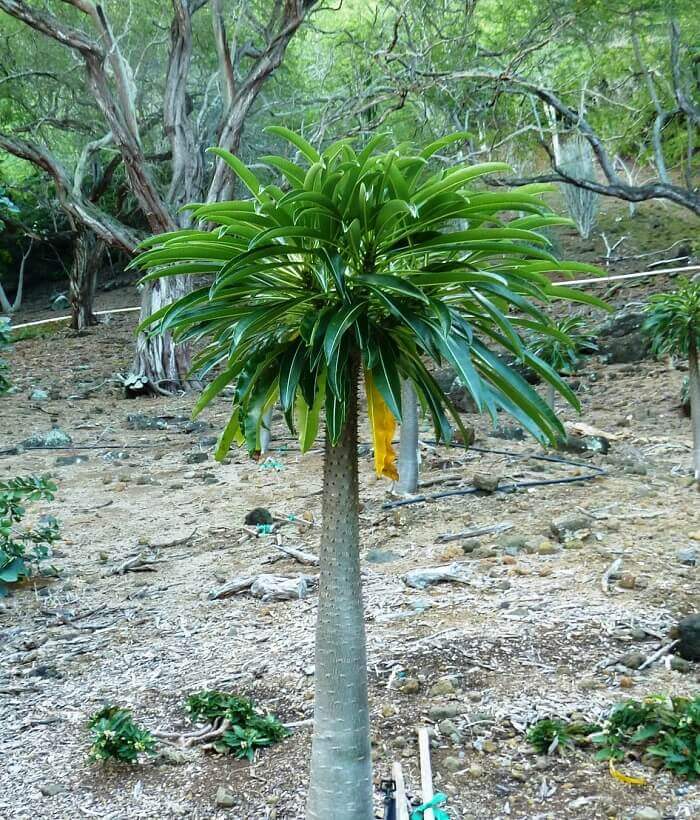

Description... The genus Pachypodium consists of 13 species of attractive, perennial, succulent shrubs or trees. Stems are thick - store moisture reserves, in most species they are covered with strong straight spines, up to 60 cm in diameter, light gray or light brown. With age, the stem sometimes forms lateral processes. The leaves are green, xiphoid, gracefully curved, arranged spirally or alternately, in the upper part of the stems, forming a crown. The flowers are funnel-shaped, appear in summer, fragrant, white, yellow or pink, with 5 rounded petals, reminiscent of scented tobacco. The plant resembles a palm tree by its appearance.
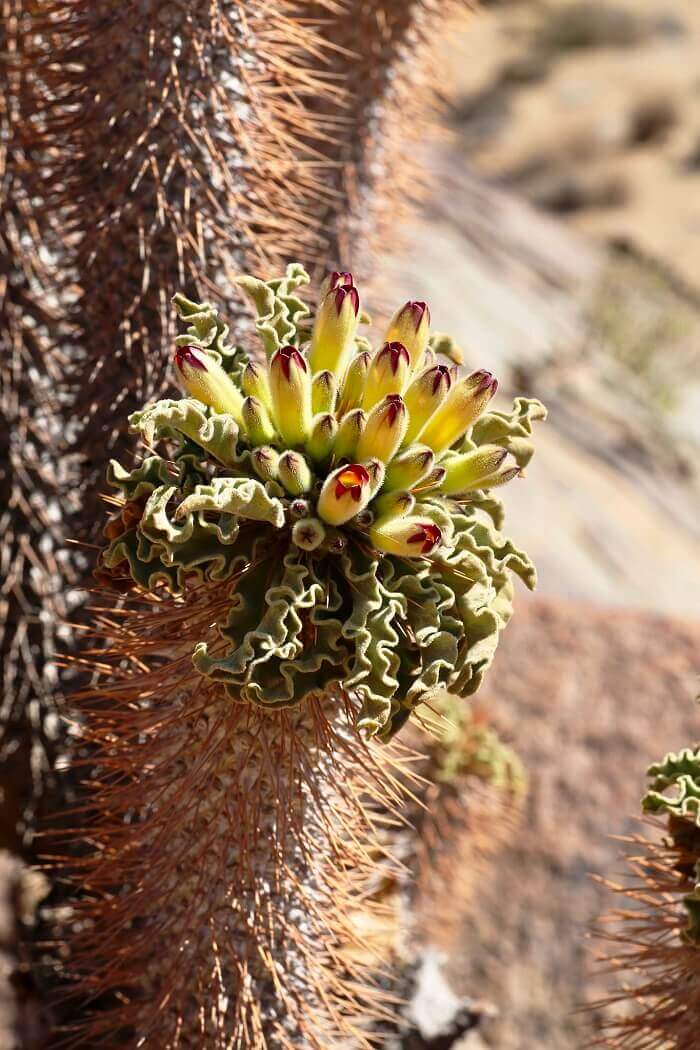

Height... In nature, it reaches 8 m, in room culture it grows slowly and often does not exceed 120 -180 cm.
Folk omens and superstitions
The following signs and popular beliefs are associated with the Madagascar palm tree:
- palm trees accepted as a gift will bring grief to the family; in order to avoid misfortune in the house, it is necessary to buy off the flower with a coin;
- Madagascar palm transforms negative energy into positive;
- when the pachypodium begins to bloom, the house is filled with love and goodness;
- the flower will save its owners from unfriendly guests, they will feel tired;
- faithfulness will be maintained in the house in which this flower is located, all family members will draw closer;
- since the pachypodium belongs to the cactus family, it is impossible to keep it in the bedroom, because the flower can adversely affect human health;
- cacti and flowers of the cactus family contribute to the emergence of alcoholism in the family, and unmarried girls are doomed to the crown of celibacy;
- single women who collect different types of succulents can find a man and marry successfully.


Whether to believe these signs and superstitions is everyone's personal business. Despite this, there are many couples who live happily growing pachypodiums. The pachypodium is a fairly popular, albeit unsafe flower in everyday life, which requires sufficient care, as well as precautions. Knowing the signs and superstitions and believing in them, you can prevent problems in the family.
Trimming the top
Sooner or later, it becomes necessary to prune the pachypodium (Madagascar palm). In favorable conditions, the plant can stretch almost to the ceiling.If you want to restrain the growth of the pachypodium, carefully trim the top of its head, which can then be rooted. The main stem will produce side shoots. Trimming is carried out as follows in four stages.
- The stem of the pachypodium is cut at the selected height with a sharp, sterile knife.
- The sections are immediately treated with charcoal powder. You can also sprinkle it on top with sulfur.
- They put the flower on moderate lighting in a room with dry air. Watering is temporarily limited. Lateral shoots will appear in about a month.
- The cut off top is planted in a separate rooting pot.
During the period of active growth, it is undesirable to rearrange the pachypodium, turn it over. Judging by the reviews, he often reacts to unnecessary interventions by partially shedding the leaves.
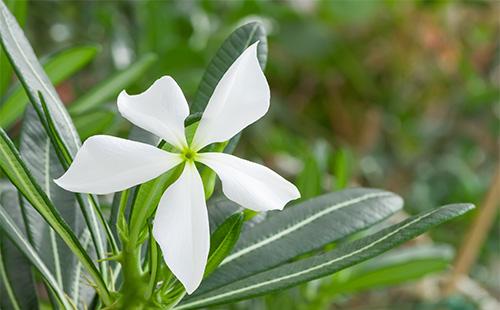

Common problems a novice florist may face
Most of the mistakes made by a florist out of ignorance will not ruin the pachypodium. But such oversights negatively affect the appearance and decorativeness of the plant. The flower itself will help to understand what exactly does not suit him. You just need to learn how to correctly interpret the "signals" given by him and react to them.
Table: how the pachypodium responds to care errors
| What does the plant look like? | What is the reason? |
| The tips of the leaves dry up, they themselves turn yellow. | Regularly drying soil in a pot. |
| The leaves lose their tone, the roots and trunk rot, the shoots are numb. | Abundant watering, especially when combined with low indoor temperatures. Worst of all in such conditions is the short-stemmed pachypodium. |
| Leaves and shoots are covered with wrinkles, turn black. | Frequent drafts or sudden changes in temperature. Or watering with cold water. |
| Leaves fall off en masse without drying out. | In the middle of autumn, this is natural for some species. At other times, "leaf fall" is provoked by a change in the position of the pot. |
| The shoots become thinner, the leaves become smaller and pale. | Lack of light. |
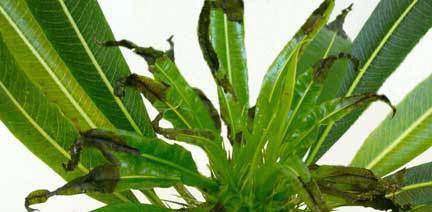

Blackening leaves mean the pachypodium is suffering from cold drafts.
How to transplant a plant correctly
The growth rate of the pachypodium, like other succulents, does not differ. However, young plants need to be replanted annually. Adults only need one procedure every 2-3 years.
The plant does not need a large pot. Each time, its diameter is increased by 2-3 cm. In this case, the container must be deep enough. One or more drainage holes are required. Better to choose ceramic pots. Plastic ones are very light, the aerial part can outweigh, and the flower will tip over.
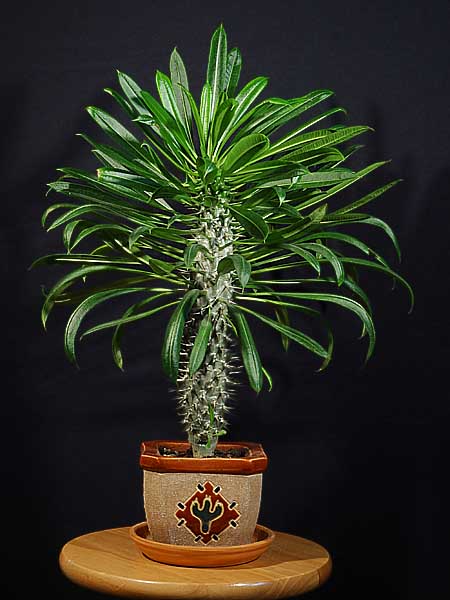

The pachypodium pot should be quite heavy and stable
The pachypodium does not need nutrient soil. In nature, it successfully survives on bare rocks. There is a special primer on sale for cacti and succulents, but experienced growers prefer to mix the substrate themselves. It is desirable that it be neutral or slightly acidic (pH 5.0-7.0).
- peat chips, coarse sand, universal soil for indoor plants or garden soil (3: 3: 1);
- turf and leafy land, sand (1: 1: 3).
In any soil, including in the store, it is useful to add pieces of charcoal or small chips from old red bricks (10-15% of the total volume of the mixture). This is a good prevention of rot, which often suffers from abundantly watered succulents.
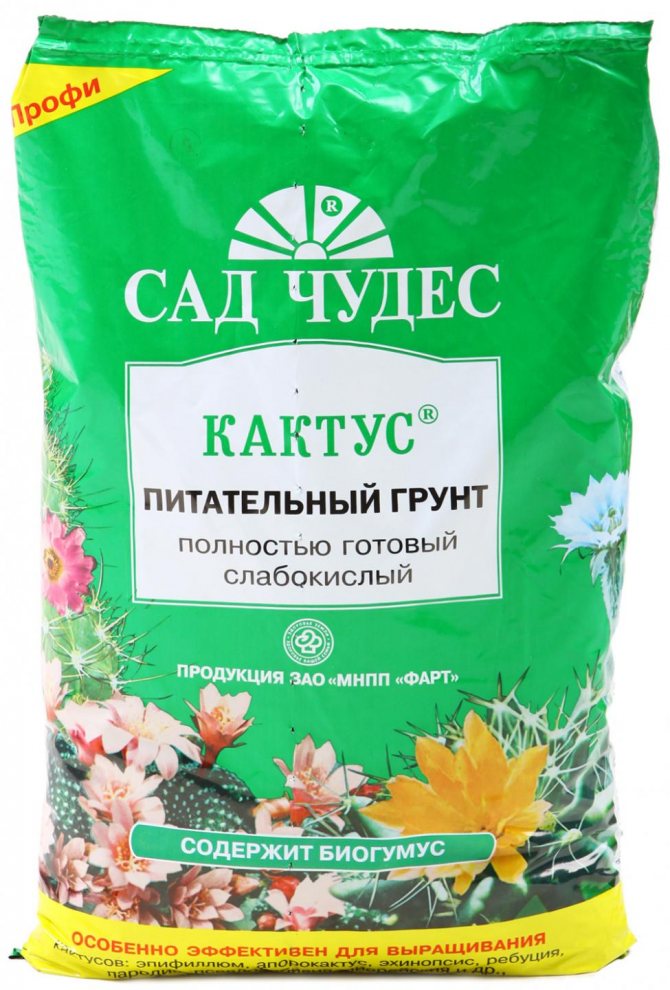

The pachypodium can be grown in special soil for cacti and succulents.
The plant transplant itself looks like this:
- Fill a third of the new pot with fine (0.3–0.5 cm in diameter) expanded clay or other material that can be used as drainage. Top - 1–2 cm of freshly prepared substrate.
- Remove the pachypodium very carefully from the old pot. Try to touch the roots as little as possible.They are fragile and delicate in the plant, they are easy to injure.
- Place the flower in a new container, add the substrate. Move the pot to light partial shade for 2-3 days.
- After the specified period, water the pachypodium. You can resume feeding no earlier than a month after transplanting.
It is almost impossible to remove the pachypodium from the pot so as not to prick or scratch. You can minimize your own injury by wrapping an old blanket or other thick cloth around the barrel.
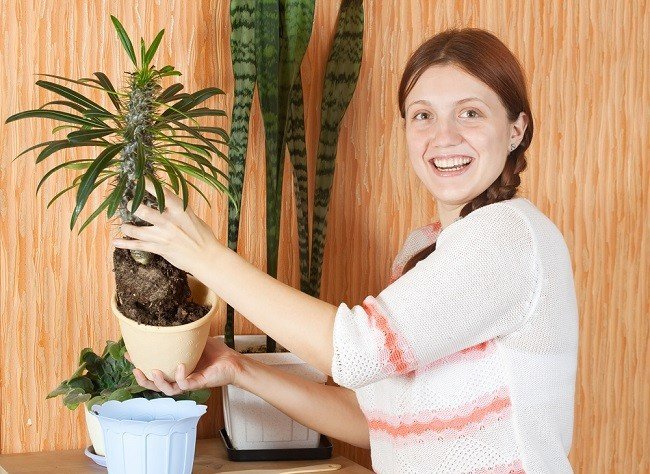

Be careful with roots when transplanting pachypodium
Video: pachypodium transplant
Photo
See more photos of the pachypodium:
Content
- Description
- Pachypodium care Cultivation
- Watering
- Fertilizing pachypodium
- Pachypodium transplant
- Bloom
- Virulence
- Diseases and their treatment
- Pachypodium Lamera (Madagascar palm)


